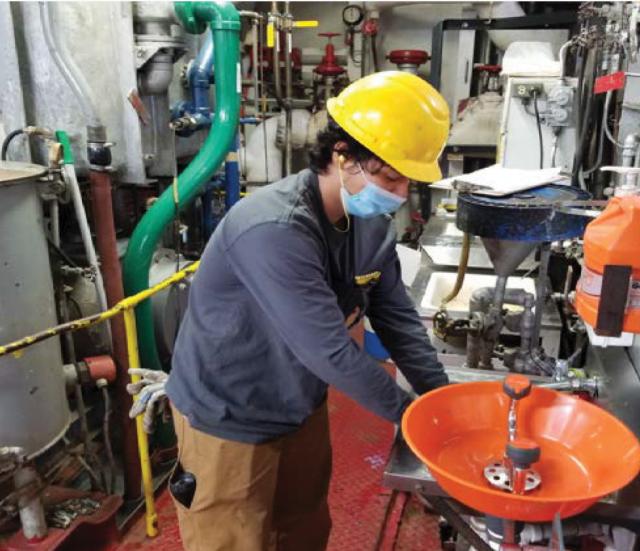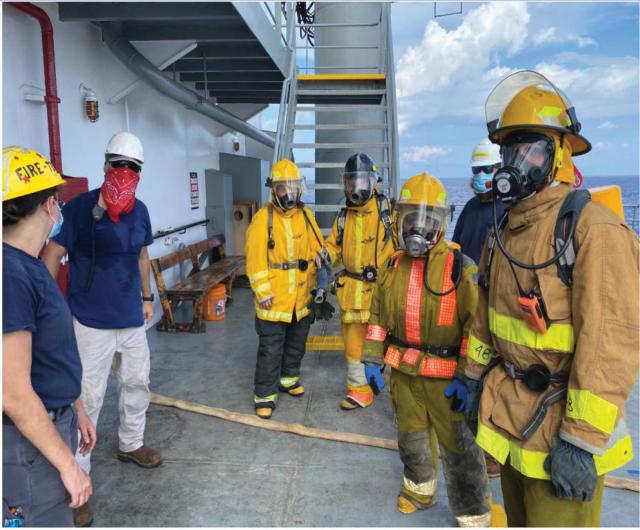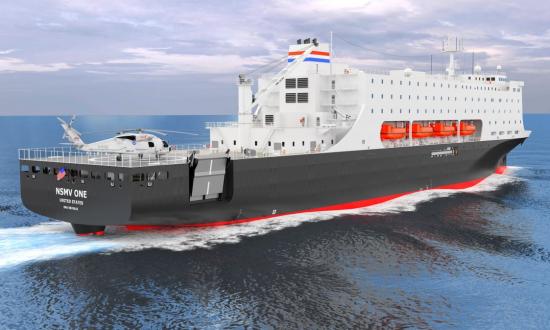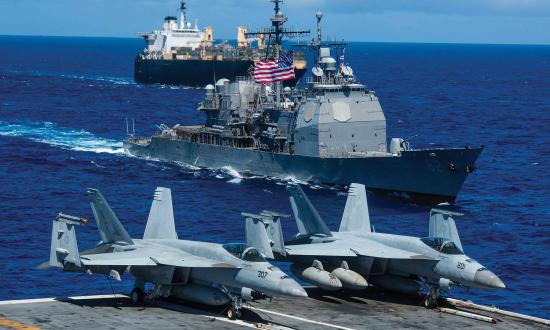The term “confused seas” describes a highly disturbed sea surface with irregular and unpredictable wave travel. For governments, industry, and people, COVID-19, unprecedented since the 1918 influenza pandemic, is synonymous with navigating confusion. For mariner at-sea training, it presents a daunting challenge.
Modern training for licensed mariners benefits from simulators and classroom training at maritime academies, but hands-on at-sea training—for a minimum of 360 days—is irreplaceable. Just as no one would fly with a pilot who had never trained in the air and soloed, no ship operator would entrust a merchant vessel carrying passengers or cargoes to a third mate or third engineer not trained on board a ship at sea. It is unthinkable.
The U.S. Department of Transportation’s Maritime Administration (MarAd) owns eight training ships whose core purpose is providing the hands-on at-sea training required to qualify cadets for their U.S. Coast Guard license examinations. The crucial third-mate or engineer license is the ticket to a career as a merchant marine officer. These ships normally are operated by merchant marine academies under maritime agreements.
One such ship is the TS Kennedy, built in 1967 and converted to a training ship in 2003.1 Operated by the Massachusetts Maritime Academy, she is capable of carrying 600 cadets on training cruises. When the pandemic hit the nation, the ship was undergoing routine maintenance at a shipyard in Mobile, Alabama.
Upon completion of work, the Kennedy was supposed to transit to Galveston, Texas, where the Texas A&M Maritime Academy planned to deploy her for its annual summer training cruise. But with the coronavirus outbreak, Texas A&M Maritime Academy canceled its summer training cruise. The TS Kennedy, however, still had to be sailed back to her home port in Cape Cod, Massachusetts.
Training ships feature tight spaces, and social distancing is not possible in many work, training, and watchstanding spaces. Berthing and messing, designed for efficiency, emphasize close living quarters and buffet-style meal service. In addition, common closed ventilation systems facilitate virus spread. The totality of the many novel challenges, physical limitations, liability risks, and ever-changing and unknown health aspects of the virus caused merchant marine academies to suspend their 2020 at-sea summer training cruises. This paralysis easily could have crippled the pipeline that supplies U.S. mariners to crew the nation’s merchant ships in peace and wartime.
For MarAd, led by Admiral Mark Buzby, the challenge had to be met head on. The U.S. merchant marine motto, “In wartime, in peacetime, every time,” allows no exception for a pandemic. Capitalizing on the opportunity presented by the Kennedy’s return voyage to Cape Cod from Mobile, MarAd conceived an at-sea training-cruise test bed—populated with student mariners—that could be used as a template for conducting safe training cruises under COVID-19 conditions. The lessons learned from this bold testing cruise would inform merchant marine academies on how to continue at-sea training during the pandemic. To make this concept a reality, a number of trust-building factors had to be addressed.
A survey identified cadets from four merchant marine academies (Great Lakes Maritime Academy, California State University Maritime Academy, Maine Maritime Academy and the U.S. Merchant Marine Academy) who were eager for sea time. Each school was offered a quota of ten volunteer cadets and a professor. Reducing the student and faculty population from several hundred to about 50 allowed for social-distance berthing and practicable compliance with relevant Centers for Disease Control and Prevention guidelines.
Coincidently, MarAd, on behalf of all state maritime academies, had just implemented an innovative program of protection and indemnity (P&I) insurance for all its government-owned training ships. P&I coverage is particularly valuable in the maritime industry because this specialty marine insurance historically has covered risks to ships, including their crews and passengers, during pandemics, providing reimbursement for medical costs, quarantine costs, repatriation, deviation, and ship cleaning, should a ship experience an outbreak.
The next challenge was crewing the ship and establishing a safe training and voyage protocol. MarAd requested one of its ship managers, Keystone Shipping Co. (Keystone), to tackle the voyage planning and preparation. With the characteristic “can do” attitude of the U.S. merchant marine, Keystone enthusiastically accepted the challenge.
Keystone prepared a 14-page training-cruise gap analysis that looked at every aspect of the activation, manning and operation, and deactivation of the Kennedy for the training voyage for 50 or so cadets and faculty, 35 crew members from the Marine Engineers’ Beneficial Association and Seafarers International unions, and two nurses. The plan required:
- Questionnaires, temperature checks, and preboarding testing and a 14-day precautionary quarantine for every cadet and crew member. During this period, one cadet and one crew member tested positive. The cadet did not make the training cruise. The crew member tested negative on two successive tests and made the cruise.
- Appropriate shipboard personal protective equipment issued to all crew and cadets.
- Institution of a “gangway up” policy restricting the crew to the ship and nonvital shore personnel from the ship.
- Second-round testing of everyone prior to boarding. Once on board the Kennedy, all individuals remained there with no shore leave for the duration of the voyage. Daily health checks were carried out by the embarked nurses.
- A separate berthing place for each person. All meals were served at a window for individual pick up, with separate silverware and napkin rolled up and items such as salad placed in individual plastic bags. After use, trays were redelivered to a clean-up window.
- Where practical, the use of face masks and the implementation of social distancing. Every space, including classrooms and labs, had identified specific social-distancing features and personnel number limits. For example, the bridge was limited to eight to ten persons, the main engine room to six persons, and the gym was divided into three zones, limited to one person per zone.
- Frequent exercise of cleaning protocols. Special linen and laundry washing protocols were implemented. Foot traffic was directed on a one-way basis.
With the voyage-planning protocol well executed, the ship, her crew, and 44 cadets and three faculty took in her lines at Mobile on 2 July 2020. After 20 days of intense at-sea training, the Kennedy arrived in Cape Cod on 22 July. None of the crew or students tested positive for COVID-19, validating both the effectiveness of the voyage planning and the attention paid to health and safety details.
These voyage statistics, however, fail to capture the high-quality training and the cadets’ enthusiastic response to the experience they gained on board. Ship Master Captain Calvin Chapman and the Keystone crew, along with the instructors, deserve special recognition and a well-deserved Bravo Zulu.
Throughout the voyage, one-on-one mentoring and aggressive hands-on training gave the students an outstanding learning experience that made this high-tempo voyage so much more than a plain vanilla training cruise. Every cadet had multiple hands-on experiences with core seamanship and shipboard engineering skills and drills. The master’s daily reports record the heavy menu of activities, including swinging the compass, Williamson and Anderson man-overboard maneuvering, piloting, celestial navigation, fire drills, bunkering, lifeboat operations, pilot ladder rigging, line-throwing gun, stability calculations, and shipboard medical training. The cadets left the cruise motivated to complete the requirements to become a licensed merchant marine officer.
The TS Kennedy training voyage, in addition to providing a memorable cruise and being a morale booster for all participants, achieved its principal goal: proving that at-sea training for mariners can be carried out safely in a pandemic environment. The lessons learned should lay the course for other training ships to leave the pier and sail with confidence in the confused seas of COVID-19.
1. The TS Kennedy will be replaced by the TS Patriot State, the second National Security Multi-Mission Vessel (NSMV) of the State class. The Patriot State is expected to be launched in 2023 in Philadelphia under a commercial shipbuilding contract between Tote Services LLC and Philly Shipyard Inc. NSMV, unlike other government ships, is built on a fixed-price basis per commercial practices.







